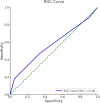Association of nutritional status indices with clinical outcomes in acute pancreatitis
- PMID: 40989798
- PMCID: PMC12451530
- DOI: 10.3389/fnut.2025.1662958
Association of nutritional status indices with clinical outcomes in acute pancreatitis
Abstract
Background/objectives: Acute pancreatitis (AP) is an inflammatory condition marked by pancreatic tissue damage due to the activation of digestive enzymes in the pancreas, triggered by various factors. Nutritional status is considered an essential factor in the management and progression of AP. The Prognostic Nutritional Index (PNI) and Controlling Nutritional Status (CONUT) score are used to assess nutritional status and may have prognostic value in AP. This study aimed to investigate whether PNI and CONUT scores at admission are associated with clinical outcomes in patients with AP.
Methods: A retrospective analysis was conducted on 261 acute pancreatitis patients admitted between 2016 and 2021. Statistical analyses included normality assessment (Shapiro-Wilk), group comparisons (Student's t-test, Mann-Whitney U, chi-square/Fisher's exact test), correlation analyses (Pearson/Spearman), logistic regression for predictors of complications, and ROC curve analysis for cut-off determination.
Results: Patients were categorized into two groups: those with (n = 132) and those without complications (n = 129). No significant difference was observed in PNI scores between the two groups (p > 0.05). However, CONUT scores were significantly higher in patients with complications (p = 0.012). In cases with necrosis, PNI scores were substantially lower (p = 0.036), whereas CONUT scores were significantly higher (p = 0.006). A significant inverse correlation was found between PNI and CONUT scores (r = -0.584, p < 0.001). The optimal CONUT cut-off value for predicting complications was ≥1.5, with a sensitivity of 67.4% and a specificity of 47.3%.
Conclusion: This study demonstrates that while PNI scores did not significantly differ between AP patients with and without complications, lower PNI and higher CONUT scores were significantly associated with the presence of pancreatic necrosis. Moreover, the CONUT score was significantly higher in patients who developed complications, suggesting its potential utility as a prognostic tool. These findings highlight the importance of early assessment of nutritional status in the clinical management of AP. The CONUT score, in particular, may help identify patients at risk for worse outcomes and guide timely nutritional interventions to improve prognosis.
Keywords: Controlling Nutritional Status score; Prognostic Nutritional Index; acute pancreatitis; clinical outcomes; nutritional management.
Copyright © 2025 Genc, Duran, Ekinci, Bayram, Uzun and Tabak.
Conflict of interest statement
The authors declare that the research was conducted in the absence of any commercial or financial relationships that could be construed as a potential conflict of interest.
Figures
References
-
- Oppenlander K, Chadwick C, Carman K. Acute pancreatitis: rapid evidence review. Am Fam Physician. (2022) 106:44–50. - PubMed
LinkOut - more resources
Full Text Sources



